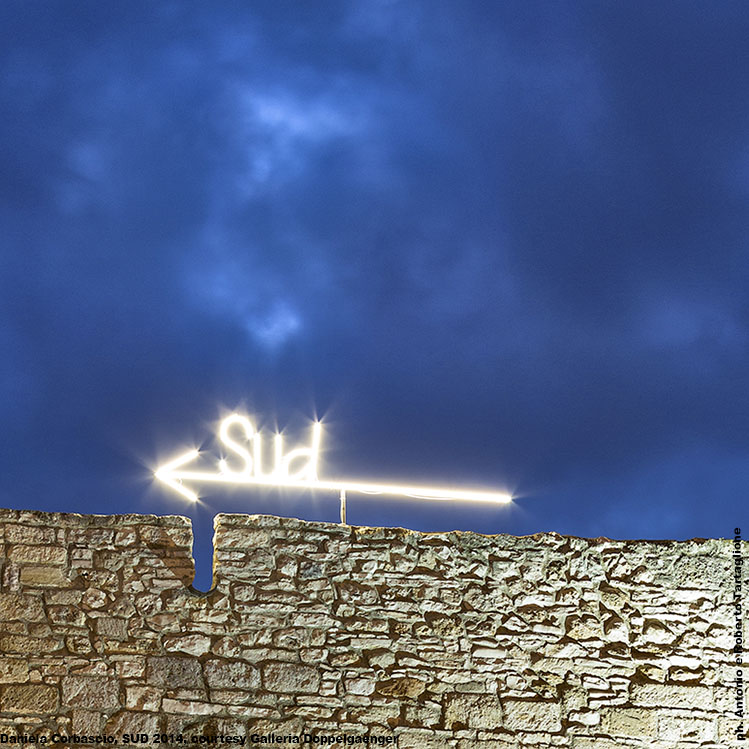
VOLARE
IN AEROPORTO
COMPANY
SAFETY
AND REGULATORY
 x
x

Three letters written in neon, using a font that recalls a handwritten letter, announce Daniela Corbascio’s Sud. The name of the place, as if it were a person, is modulated along a long crossbar that ends in a slender arrow. The glass shaft is the luminous vehicle of the message, indicating first and foremost a direction of the spirit, more than of the space. The synthetic quality of the light already suggests this direction, a candour suffused with pink vapour, like when the dawn begins to brighten the horizon along the eastern seafront. Thus the installation finds its epiphany in relation to the places chosen by the artist. The arrow of the South (Sud) stretches out in dialogue, with signs of Power and Memory, Imagination and Commerce, which speak of the Past and Present of the artist’s city: Bari. The massive structure that is the Norman-Swabian Castle with its load of history and stories close to the ancient heart of the city, resistant to the processes of gentrification. Exotic hints of the declining grace of the former Kursaal Margherita, covered with animations and wandering dreams of contemporary art, at the point where its concrete piles meet the pontoons of the Sailing Club, and where they give convention to the worldly and cultural rites of ruling classes of the city in elite name of marine sport. The smooth modernism of the building in which the central branch of the Banca Nazionale del Lavoro is housed, in the heart of the Murat zone of the city, almost to mark the original character of a society of merchants and professionals. It was to this first unit that the arrow was added, hovering over a high ridge of the massive twentieth century building on the seafront, taken in by the government of the Apulia Region, to quietly suggest new directions needed for historical destinies. Finally, last in time but not in the senses, the arrow, perched on this ancient tower of a falconer, within the territory of an airport in continuous desire for expansion, as if holding still, in a sky furrowed by multiple flight routes. The magnetic needle on the pole of identity.
Yet this sign of the South neither surmounts these places, nor pierces them; rather it seems to float, seeking the oblique point of the edge, the side, the angle, the “right distance” for the gaze of the passer–by, whether local or foreign, and the right relation with the context of Nature and Culture within which the signs in stone rise up. It accepts almost disappearing in daylight and emerging again at twilight in competition with the city’s colourful lights. For the South which Daniela illuminates isn’t an imposition, but rather an intimacy, a declaration of love. Nor does it indicate, necessarily, an orientation toward Southern Italy. It’s an emblem which affirms, with an obstinate tautology, the presence of the South in a city of the South.
The turning point is right here, in the long career of an artist who is one of the few in Italy to have systematically manipulated neon tubes as the basic or defining medium of an aptitude for large–scale installations, whether in open or closed spaces, diversifying from formal structuralism to restless visionary contaminations. It’s a suffered choice to reduce the use of “light writing” almost to the historical limit of a culture of conceptual–minimalism, in order to reveal the secret of a cultivated obsession by means of raw, pure artificial light, in the depths of an existential adventure as the artist poured in the generosity of making and communicating. The South, like an inner condition, the archetypal source in which personal experience, private memories, and the narratives of a society, its times and places, are rediscovered and collected. The beauty and affliction of the South, the intelligence and misery, Dionysian vitalism and Apollonian nature overlap and merge in Daniela’s fervent imagination, evoking a fabulous heimat, a homeland that extends from the Mediterranean to the lands of Africa and Asia, and beyond the Pillars of Hercules…an imaginary geography in which her whole self is reflected and projected, blending individual pride and ancestral fears in a sort of local fundamentalism.
This pulse of memories and disdain, of emotions and ideas, has been courageously depicted by the artist in an exercise of extreme linguistic asceticism: in pouring the urgency of her expressive magma into the naked, self–referential firmness of the utterance “Sud”, while at the same time tracing its hallucinatory movement through public space. A movement that resembles street art. A luminescent script, connoted by different modes of repetition. The structural concept of the installation is always the same, but it’s perceived size and height vary according to the space in which it is collocated. And each time the message also changes, its prevalent meaning, in a dialogue with the functional and symbolic apparatus of each different structure in the city.
Here, the installation of Daniela Corbascio unites as a significant contribution to the formulation of the Apulian culture in a concept of public art, renewed in the sense of social intervention, but kept on the linguistic edge of distance and detachment. Thus the proposal – or rather the dream – creeps between the signals of urban life with phantasmal virtuality of “open work”. Moreover, the vision of the South as an enigmatic metaphysical evocation, solicits the reaction, interpretation and enquiry of all who encounter it.
This is the “inner need” of a project that has been slowly maturing its evidence, ever since 2000, when a door on the seafront was installed in front of the provincial government offices. For now, in her sceptical and confused city, the luminous signature of an irrevocable decision appears: “I want to be here”.
PIETRO MARINO
(English translation by Lisa Adams and Mika Silhanek)